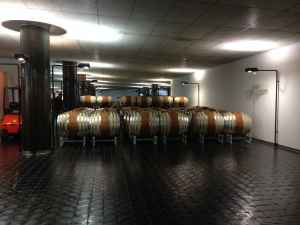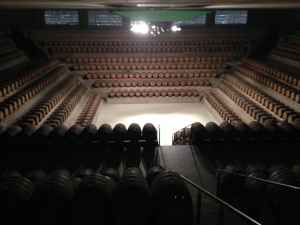Tuscany in February - Modernity and Tradition
It’s February most of Cornwall is underwater and with the rail lines washed away again it feels like the County is once again cut off from the rest of the country. Well, Italy is in a similarly wet and windy boat. It was against this soggy background that I was lucky enough to spend a couple of days in Tuscany this February.
Tuscany is the wine region I know best. I’ve now been three times, but it continues to fascinate me. Sangiovese remains one of my all time favourite grapes. I love it’s slightly elusive, aromatic, occasionally rough and edgy character. Sangiovese is like the working class cousin of Pinot Noir, the same hard to pin down qualities but rougher and less effeminate. I love too the way the Italians keep changing the rules for Chianti, but never quickly enough to keep up with what producers are actually doing.
So it was a real treat to go back for another installment. The trip was courtesy of Bibendum Wines and in the company of Stuart Grundy, their European Buying Director. Stuart is carrying out a quiet, but root and branch, re-shaping of Bibendum’s Italian portfolio, so it was great to hear his perspective on the region.
We visited three wineries; Ca Marcanda, the Bolgheri outpost of Piedmonte legends the Gaja family, then South of Chianti in the Maremma, the extraordinary and ultra modern Rocca di Frasselino and finally, in the heart of Classico, the traditionalist Castellare. Taken together the three make a fascinating cross section of wildly different styles and approaches.
Ca Marcanda was first and for this we were hosted by the relaxed, approachable and generally delightful, Gaia Gaja. Gaia is the daughter of super famous Antonio Gaja who since the 70’s put his name firmly on the wine map of Barbaresco and Barolo. Daughter Gaia is increasingly involved in running this hugely successful estate. The family made it’s name producing top quality Barolo and Barbaresco before investing in Bolgheri with the purchase of the Ca Marcanda Estate in 1996.
Bolgheri is different from the rest of Tuscany. It was only developed as a wine region from the 70’s, it is coastal, flat and it grows grapes like, Merlot, Cabernet Franc, Cabernet Sauvignon and of course some Sangiovese. It may in fact be a bit too warm for Sangiovese and many of it’s most famous wines are resolutely international in style.
Gaja explained that the attraction of the region to her father was exactly this freedom from tradition and accepted rules. The Ca Marcanda winery is modern, spotless and beautifully designed, but modest, grass roofed and almost hidden from view. We had a quick tour before settling down to taste some wines.
Bolgheri has two main soil types, brown clay and a white clay. The white clay is found closer to the hills and is see as the best soil. We tasted samples of both Merlot and Cabernet Franc one from the brown and the other the white clay. There were clear differences; the white soils giving more aromatic, lighter and fresher wines.
The wines we tasted were these:
1. Promis 2012. 55% Merlot, 35% Syrah, 10% Sangiovese. Vibrant, aromatic ripe plum and sea breeze nose, then a silky mouthfeel with ripe fine grained tannin, spice and clove.
2. Magari 2012. 50% Merlot, 25% Cabernet Sauvignon, 25% Cabernet Franc. Showing a bit more oak on the nose with vanilla, clove and smoke. Plenty of plummy fruit, more tannin but again very ripe and fine, all nicely balanced with great acidity.
3. Ca Marcanda 2012. 50% Merlot, 40% Cabernet Sauvignon, 10% Cabernet Franc. This is made from grapes grown in the white and more stony soils. Yields are lower and the wine is correspondingly more concentrated. As such it is given additional oak, now a full 18 months in barrique. The fruit now is deeper and darker with darker plum almost damson fruit, more tannin, more concentration and weight. Very silky mouthfeel. It’s getting close to being huge but again the acidity comes to the rescue, cleaning up the palate and giving a good balanced finish.
4. Ca Marcanda 2011. Very nice use of oak here, more silky and full again this vintage.
What all of the wines have in common is a drinkeable, vibrant, acidity that balances out the intense and long lived Bolgheri fruit. Certainly Ca Marcanda has additional weight and concentration but remains very drinkeable. My personal favourite was the Magari.
The next winery we visited was further South in the area known as the Maremma. This used to be an area of marsh and swamp so is again relatively young. The winery we visited was Frasselino, owned along with Castellari by multi millionaire Mr Pannerai of watches fame.
The winery building, designed by architect Renzo Piano no less, is immense and has a vast inverted pyramid barrel cellar. Certainly the largest cellar I have ever seen with a mind boggling roof that must span close on 40m. The building is impressive but for me personally sent out worrying signals of ego, masculinity and general pomp. I have a pet theory that I don’t like wines made by people with massive ego’s; they all too easily go for massive extraction, too much oak and make tiring wines I just don’t like.
Having seen the building and sat at the immense, illuminated, board-room style tasting table all the alarm bells were sounding! I almost expected Alan Sugar to call us in. But, what a lovely surprise; there was a real freshness, delicacy and elegance in the wines, hooray! Something else to celebrate are the prices; clearly the cost of the building is not being passed on.
The estate grows a range of international grapes as well as the Sangiovese clone known as Sangiovetto from the Castellare Estate in Chianti Classico.
1. Vermentino 2012. Currently not imported into the UK. Which is a shame as I really liked this. Spicy pear nose, medium body and nice balance of freshness and ripeness, finishes with grapefruit and herbs – in a good way.
2. Poggio alla Guardia 2010. 45% Merlot, 10% Cabernet, 15% Sangioveto. This is the entry level red without oak ageing. I think I must be a cheap date! I often like these lighter entry level wines for their simple pleasures. This has vibrant red fruit on the nose and palate, its quaffable, medium bodied and with a nice savoury edge.
3. Ornello 2009. 40% Sangioveto, 20% Syrah, 20% Cabernet, 20% Merlot. This sees 10 months in barrique. Has savoury meaty notes, blood, clove and black pepper. It is complex but fresh too.
4. Le Sughere di Frassinello 2009. My favourite of these wines. Its from 50% Sangioveto, 25% Merlot and 25% Cabernet and has 12 months in barrique. Ripe, spicy nose, lots of aromatics, more tannin; just elegant, balanced and very easy to drink.
5. Rocca di Frasinello. 60% Sangioveto, 20% Merlot, 20% Cabernet, 14 months in mostly new barrique. Fairly restrained smokey deep nose, plush fleshy palate, quite serious now. Its great, but Sughere is more fun.
6. Baffonero. 100% Merlot. This specifically designed to compete against Masseto from Antinori for the crown of the greatest Bolgheri wine. Well, it certainly has concentration but it’s not my favourite. In fairness it probably needs 10 years in bottle to develop.
The following day we arrived at Castellare. There could not be a bigger contrast from Frassellino. The estate is right in the golden triangle that forms the heart of Chianti Classico. The vineyards form a beautiful South West facing amphitheatre and the soil is the classic clay marl called Galestro.
Castellare are proud to have a clone of Sangiovese they call Sangiovetto. Alongside this they grow the very traditional Malvasia Nera. They do grow a little Merlot and some Cabernet but these are vinified separately and are not used in the Chianti. Everything at Castellare is about tradition and we were fortunate enough to taste these wines over an equally delicious and highly traditional Tuscan lunch.
1. Chianti Classico 2011. Classic Chianti, a nice aromatic slightly savoury nose, plenty of acidity, medium weight. Just lovely with the food and incredible value too.
2. Chianto Classico Reserva 2011. More weight and a silkier plusher mouthfeel. More tannin but ripe and agreeable. Probably my favourite of these wines as it had that mid range balance of weight versus acidity.
3. I Sodi 2010. This is weighty, more complex and more serious all round, also considerably more expensive. It would certainly reward a few years in the cellar.
So, what conclusions from this amazing trip?
1. Chianti is still a classic style. The time at Castellare proved just how relevant these wines are. Perfect with food, rarely tiring and right on message for today.
2. Bolgheri is a great place to grow grapes. The quality of the frit in the Bolgheri wines is remarkable. These are from pretty young vines and already they are impressive. The fruit seems to have a vibrant, youthful power that is almost new world in style. Cabernet Franc in particular seems to be good here.
3. For me Sangiovese is better unblended. Sure there are exceptions, but I love Chianti for what it is and Bordeux blends for what they are. I’m less certain how Sangiovese adds to the mix, too often its character can be lost in a blend.
4. Delicacy and restraint are key. For me the most successful wines are those mid range styles with plenty of zingy aromatics, yes some flesh but also restraint.
Wines I plan to list are:
• Magari from Ca’ Marcanda
• Poggio al Guardia from Rocca di Frasinello
• Sughere di Frasinello from Rocca di Frassinello
• Chianti Classico and Reserve from Castellare
I hope you found this interesting. Comments and questions gratefully received!
The Ca Marcanda range - the label design comes from the road in Bolgheri where Gaja is photographed below
 Gaia Gaja our hostess
Gaia Gaja our hostess
 The Ca Marcanda Winery
The Ca Marcanda Winery
 Inside Ca Marcanda winery, all modern and absolutely spotless
Inside Ca Marcanda winery, all modern and absolutely spotless
 The Gaja Piemonte Wines (dod not taste these)
The Gaja Piemonte Wines (dod not taste these)
 No its not a spaceship its the Rocca di Frassinello Winery
No its not a spaceship its the Rocca di Frassinello Winery
 Absolutely huge barrel cellar, like a sports stadium and really huge echoes
Absolutely huge barrel cellar, like a sports stadium and really huge echoes

 Great oil too from the Castellare Estate
Great oil too from the Castellare Estate
 Everything about Castellare says tradition!
Everything about Castellare says tradition!
 Castellare labels show native birds that endangered, a different one each vintage
Castellare labels show native birds that endangered, a different one each vintage

 Gaia Gaja our hostess
Gaia Gaja our hostess
 The Ca Marcanda Winery
The Ca Marcanda Winery
 Inside Ca Marcanda winery, all modern and absolutely spotless
Inside Ca Marcanda winery, all modern and absolutely spotless
 The Gaja Piemonte Wines (dod not taste these)
The Gaja Piemonte Wines (dod not taste these)
 No its not a spaceship its the Rocca di Frassinello Winery
No its not a spaceship its the Rocca di Frassinello Winery
 Absolutely huge barrel cellar, like a sports stadium and really huge echoes
Absolutely huge barrel cellar, like a sports stadium and really huge echoes

 Great oil too from the Castellare Estate
Great oil too from the Castellare Estate
 Everything about Castellare says tradition!
Everything about Castellare says tradition!
 Castellare labels show native birds that endangered, a different one each vintage
Castellare labels show native birds that endangered, a different one each vintage


